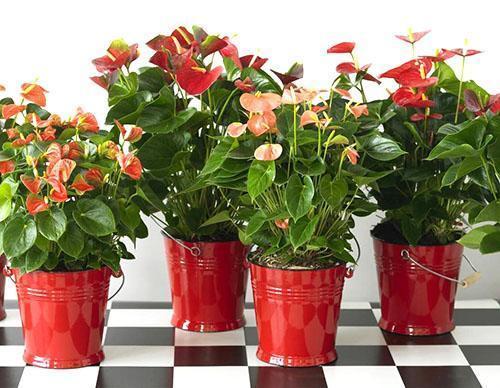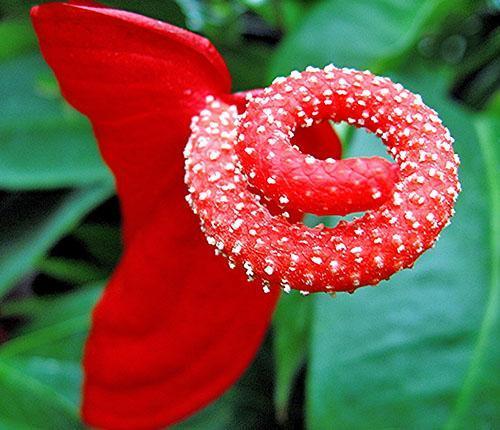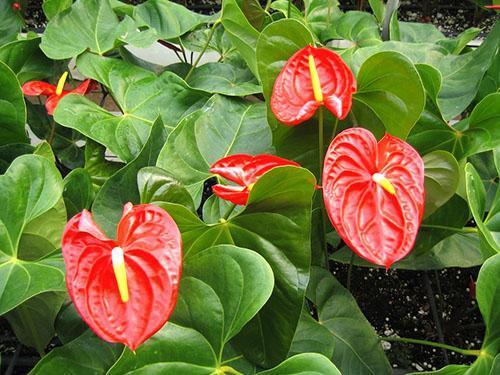Anthurium male happiness in a flower pot
 The tropics are a plant paradise that has probably not revealed all its secrets over the past centuries. The variety of forms and species that live here still attracts naturalists and botanists. And the most striking discoveries were made in the era of the Great Geographical Discoveries and the following decades.
The tropics are a plant paradise that has probably not revealed all its secrets over the past centuries. The variety of forms and species that live here still attracts naturalists and botanists. And the most striking discoveries were made in the era of the Great Geographical Discoveries and the following decades.
Discovery history and origin of anthurium

Most of the representatives of the genus are epiphytes that live on trees in tropical forests, lianas with long aerial roots and species that have adapted to live on rocky slopes, fixing themselves on bare stones and tiny deposits of humus.
Anthurium flower name in Latin comes from the words "tail" and "flower", which very accurately reflects the appearance of the inflorescence of a tropical plant. But the people call the plant "flamingo flower", "red tongue", but also called anthurium and male happiness. Sometimes flower growers who grow anthuriums on their windowsills do not know the history of the name, but they are sure that the plant has a beneficial effect on the atmosphere in the house. So what is remarkable about anthurium, and what does this flower mean?
A symbol of male happiness - anthurium from South America
 There is a belief that this unusual name of the plant originated in the pre-Columbian era among the local tribes inhabiting the homeland of anthurium - Colombia. A legend has survived to this day explaining the origin of the anthurium.
There is a belief that this unusual name of the plant originated in the pre-Columbian era among the local tribes inhabiting the homeland of anthurium - Colombia. A legend has survived to this day explaining the origin of the anthurium.
When the world was very young, and the gods still often descended to people, a young girl lived in one village, beautiful as a fresh forest flower. The brave hunter loved her, and soon wedding hymns were supposed to sound for them, but something terrible happened. The envious and evil leader of the neighboring tribe, having found out about the beauty of the young maiden, desired to make her his concubine. With a detachment of soldiers, he came under the walls of the village and took it by storm. Many in the village died at the hands of bloodthirsty invaders, and the girl's beloved could not survive. Overjoyed by the victory, the leader felt omnipotent and ordered the elders to bring the beauty to him.
The proud girl opposed, put on the best red outfit prepared for the wedding, and threw herself into the fire of the conflagration, so as not to get the villain. Before the spark had time to fly up to the sky, the gods saw the evil happening on earth and turned the beauty into an anthurium flower.
 Since then, a jungle has long grown on the site of the devastated village. There is not a trace of the passions that once raged here, only anthuriums bloom on the stones and roots of tall trees. And the drops flowing from the leaves remind of old events, like the tears of a girl who misses her beloved and mourns the destroyed love and happiness.
Since then, a jungle has long grown on the site of the devastated village. There is not a trace of the passions that once raged here, only anthuriums bloom on the stones and roots of tall trees. And the drops flowing from the leaves remind of old events, like the tears of a girl who misses her beloved and mourns the destroyed love and happiness.
 The story is bitter, but in Colombia they believe that anthurium is a wonderful talisman for newlyweds, which protects them and protects them from mistakes and quarrels.In bouquets given for weddings in South America, the anthurium flower means a wish for happiness and prosperity.
The story is bitter, but in Colombia they believe that anthurium is a wonderful talisman for newlyweds, which protects them and protects them from mistakes and quarrels.In bouquets given for weddings in South America, the anthurium flower means a wish for happiness and prosperity.
To representatives of a strongly sexed flower, the flower can bring exceptional masculine strength and the ability to stand up for loved ones. Therefore, the plant is necessarily present in the decoration of rooms for a young couple and after the wedding.
What do these interesting plants look like?
Many-sided anthuriums
 Since the genus is very numerous and diverse, a huge region from Mexico to the north of Argentina and Uruguay can be considered the birthplace of anthurium. The most famous plants, which have long found their place in greenhouses and indoor pots, and still poorly studied varieties live here.
Since the genus is very numerous and diverse, a huge region from Mexico to the north of Argentina and Uruguay can be considered the birthplace of anthurium. The most famous plants, which have long found their place in greenhouses and indoor pots, and still poorly studied varieties live here.
Despite the fact that Europeans have been familiar with anthurium since the second half of the 19th century, a small proportion of species of this unique plant are grown at home. Most often, flowering varieties can be found in culture, among which the Andre anthurium, named after the discoverer, is the leader, as well as the Scherzer anthurium. Then numerous interspecific hybrids and varieties obtained from these species appeared and had already managed to gain popularity.
In plants of the André species, the origin of the anthurium and its relationship with other representatives of the Aroid family are most clearly guessed. A flower, or rather an inflorescence of a plant, is a dense, even ear, surrounded by a bright glossy blanket.
 In their homeland, wild-growing anthuriums form only a bright red bracts, but today, thanks to selection, it has been possible to obtain varieties that amaze with a variety of palette, sizes and shades of inflorescences. In addition to reds, you can find white, pink, lilac, almost black, and green bedspreads. But these are not all surprises prepared by a tropical plant for indoor crop lovers.
In their homeland, wild-growing anthuriums form only a bright red bracts, but today, thanks to selection, it has been possible to obtain varieties that amaze with a variety of palette, sizes and shades of inflorescences. In addition to reds, you can find white, pink, lilac, almost black, and green bedspreads. But these are not all surprises prepared by a tropical plant for indoor crop lovers.
If Andre's anthurium has an almost even ear, then Scherzer's anthurium, nicknamed the "flamingo flower", stands out with a bizarrely curved ear, which can be not only white, yellow or pink, but also bright red.
With proper lighting and watering flowering of anthurium "male happiness" can go all year round, and the inflorescences do not lose their attractiveness for up to a month. When the veil withers and the tiny flowers that make up the ear are pollinated, the ovary begins to form. Anthurium fruits are yellow or reddish-orange berries containing two seeds.
 The decorative foliage of anthurium "male happiness" is as diverse as the flowers. Oval, pointed-heart-shaped and dissected leaves of all sizes and colors are the second most important decoration of the culture. At the same time, the surface of the leaf plates, which can turn following the movement of the sun, can be both glossy and matte, and an even green color is adjacent to a variegated one.
The decorative foliage of anthurium "male happiness" is as diverse as the flowers. Oval, pointed-heart-shaped and dissected leaves of all sizes and colors are the second most important decoration of the culture. At the same time, the surface of the leaf plates, which can turn following the movement of the sun, can be both glossy and matte, and an even green color is adjacent to a variegated one.
Species with unusual foliage were allocated by flower growers to the group of decorative deciduous anthuriums.
Among them are also many very interesting and worthy of growing at home plants, such as the anthurium cristallinum from the Colombian rainforests.
Can anthurium be kept at home?
 According to the same old legend about the origin of the anthurium, the girl's pride did not disappear after she turned into a flower. In order not to fall into evil hands, the plant received caustic juice from the gods. Today the legend has a more plausible scientific explanation. All parts of anthurium, like other plants of the Aroid family, contain calcium oxalate, which indeed has toxicity and the ability to cause damage to mucous membranes.
According to the same old legend about the origin of the anthurium, the girl's pride did not disappear after she turned into a flower. In order not to fall into evil hands, the plant received caustic juice from the gods. Today the legend has a more plausible scientific explanation. All parts of anthurium, like other plants of the Aroid family, contain calcium oxalate, which indeed has toxicity and the ability to cause damage to mucous membranes.
So can anthurium be kept in the house? Will the plant harm people?
The content of the dangerous substance in the green parts of this native of South America is not so great, so there is no health risk for the adult inhabitants of the house. But from small children and animals that can taste the foliage, it is better to remove the anthurium away.Certain types of anthurium have a pronounced aroma, which must be taken into account if a person lives in the house with an increased sensitivity to odors.
For the rest, a tropical plant not only does not pose a danger, but can also be useful. Anthurium is able to assimilate a number of harmful volatile compounds that enter the house, for example, from vehicle exhaust or plastics. Such substances include xylene and toluene. Since the plant loves moisture, then for its well-being, the grower will have to regularly humidify the air, which has a positive effect on human health.
Anthuriums "male happiness" are not only popular indoor plants, but also cut flowers widely used in the design of bouquets and interiors. This is due to the spectacular appearance of the inflorescences and their ability to maintain freshness for up to six weeks. The main trick here is to cut off the peduncle in time, when the coverlet is fully opened and the ear is sprinkled with pollen.